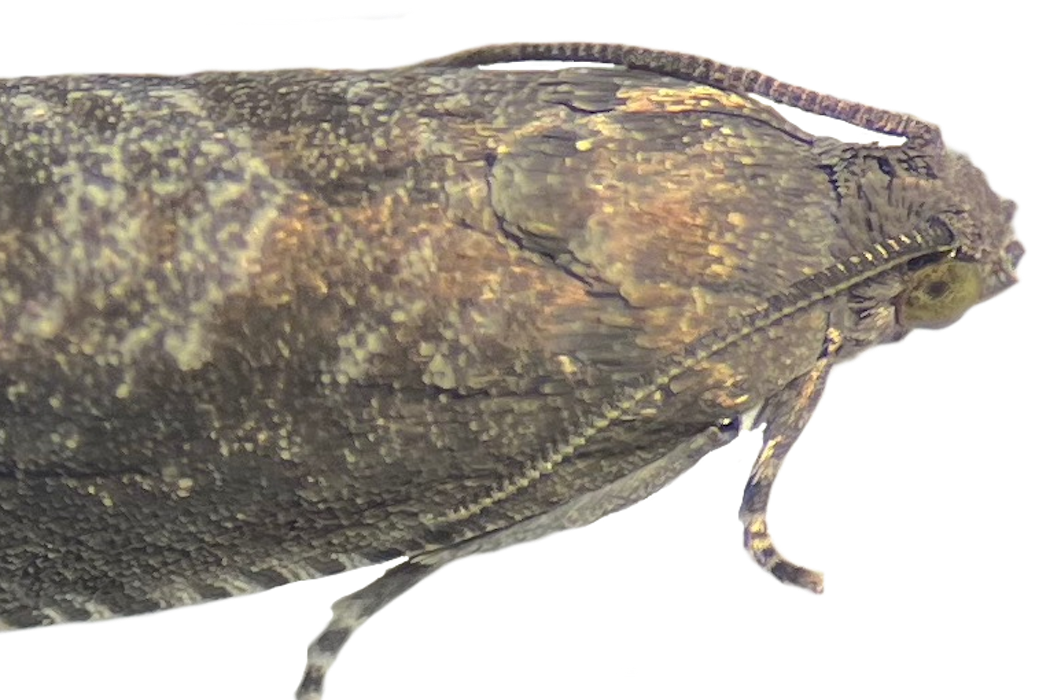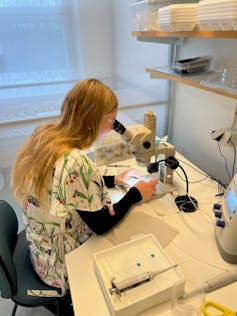
A single “sexy” gene could help us combat one of the world’s most destructive fruit pests. By deleting the gene that lets female moths produce their mating scent, colleagues and I created an “unsexy” moth – and showed one way to turn insect attraction into a powerful pest control tool.
You’ve probably seen moths flittering around a bright lamppost on a balmy summer night. Those same insects, in their larval form, are the worms that burrow into your apples and peaches, making them serious pests in agriculture.
Moths are usually controlled with chemical pesticides, but pests evolve resistance and these sprays also harm bees and other pollinators. We need new and more sustainable methods to protect important crops targeted by moth larvae, like apples, maize, tomatoes and rice.
In a new study published in the Journal of Chemical Ecology, colleagues and I have demonstrated a way to unravel sexual communication in insects and provide a more sustainable alternative to pesticides. It seems we can stop moths by using their natural instincts against them.
Moths find their mates through chemical communication. Female moths release a species-specific pheromone, which males can detect and follow over long distances.
Farmers have long used synthetic versions of these pheromones to lure male moths away from females so that they don’t reproduce. But the problem is, every species has its own unique blend of pheromones, and replicating the exact recipe in a factory can be costly.
To achieve pheromone-based control on a large-scale, we need to understand how insects make them in the first place – and find the genes responsible.
How we found the sexy gene
Our study focused on the oriental fruit moth (Grapholita molesta), a serious pest on peaches, apples and other fruit. We wanted to identify the gene responsible for making its pheromone.
Pheromones are made from fatty acids by a specific enzyme. To find the genetic material responsible for that enzyme, we needed to identify the fatty acid, the enzyme and eventually the gene.
The fatty acids from which moth pheromones are derived are the same ones that all organisms make in abundance – like the fats in cooking oils and butter.
We first found the small fatty acid that served as the raw material for the moths’ scent, using a technique called gas chromatography, which separates fatty acids based on their size. When we placed this particular fatty acid onto the moth’s pheromone gland, it was converted into the pheromone, confirming we had the right starting point.
Next, we needed to find the exact enzyme that turned that specific fatty acid into that specific pheromone. The key was a double bond between two carbon atoms – that’s a job done by enzymes called desaturases. Searching the moth’s DNA we found many desaturase genes, but only one that was active in females but not in males. This looked like the right gene.
Creating an unsexy moth

To test the gene’s function, we used Crispr – a precise gene-editing tool sometimes described as “genetic scissors” – to delete the suspected desaturase gene in moth eggs. When the moths grew into adults, females without the gene could no longer produce their pheromone, confirming it as the crucial link in their sexual communication.
Silencing this single gene meant we’d effectively created an “unsexy” moth – one that couldn’t hope to attract a mate. Our method can also be applied to different species, including other pest moths that make similar pheromones.
Pest control with insect genes
Chemical pesticides remain the main defence against crop pests, but resistance is spreading fast and pesticides are linked to soil contamination, pollinator declines and more.
Pheromone-based pest control avoids these problems. When synthetic pheromones are spread in a field or orchard, males become confused because they follow the synthetic trails instead of those made by the female moth, reducing their breeding success.
Our “unsexy” moths helped us identify the exact gene behind this mating signal. Knowing which gene produces the pheromone means we can now reproduce the pheromone outside the insect – for example, by inserting the gene into yeast or plants that act as “biofactories”.
These engineered organisms can then produce the pheromone naturally and cheaply, the same way we use genetically modified yeast to make medicines like insulin.
Our discovery connects lab research to real-world pest management: by decoding the moth’s love signal, we’ve taken a step towards greener, gene-based production of pheromones that could one day replace chemical pesticides.
Marie Inger Dam is a co-inventor on several patent applications relating to pheromone production.
This article was originally published on The Conversation. Read the original article.







